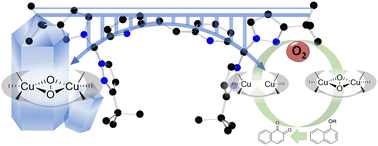A novel dinucleating bis(pyrazolyl)methane ligand was developed for tyrosinase model systems. After ligand synthesis, the corresponding Cu(I) complex was synthesized and upon oxygenation, formation of a µ-η2:η2 peroxido complex could be observed and monitored using UV/Vis-spectroscopy. Due to the high stability of this species even at room temperature, a molecular structure of the complex could be characterized via single-crystal XRD. Additional to its promising stability, the peroxido complex showed catalytic tyrosinase activity which was investigated via UV/Vis-spectroscopy. Products of the catalytic conversion could be isolated and characterized and the ligand could be successfully recycled after catalysis experiments. Furthermore, the peroxido complex was reduced by reductants with different reduction potentials. The characteristics of the electron transfer reactions were investigated with the help of the Marcus relation. The combination of the high stability and catalytic activity of the peroxido complex with the new dinucleating ligand, enables the shift of oxygenation reactions for selected substrates towards green chemistry, which is furthered by the efficient ligand recycling capability.
